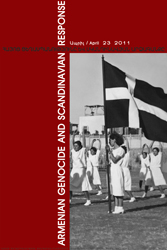23.04.2011

The Armenian Genocide had a major impact on the international community from the moment the information about the massacres being implemented by the Young Turks reached foreign offices and appeared on the front pages of newspapers in 1915, thus becoming a reason for the public humanitarian response and protest. In this regard, the Scandinavian countries were no exception.
Individuals, organizations, and governments in Sweden, Norway, and Denmark reacted in a variety of ways to the ongoing massacres in Armenia. The first records about the help from the Scandinavian countries to the Armenians being persecuted by the Turkish tyranny dated back to 1890s during the reign of “Bloody Sultan” Abdul Hamid II. In reply to the committed crimes, in the Scandinavian countries many books were published and steps were taken to help the suffering Armenians.
Swedish, Norwegian, Danish diplomats, missionaries, relief workers in the Ottoman Empire as well as many individuals in Scandinavian countries - writers, priests, reporters, even school children contributed to raising the awareness of the Armenian atrocities and their human and political implications and collected funds for the humanitarian aid. The Scandinavian missionaries’ work to aid the Armenian population of the Ottoman Empire was coordinated by the Danish, Norwegian and Swedish “Women Missionary Workers” organization (KMA in Danish: Kvindelige Missions Arbejdere).
Founded in Sweden in 1894 KMA branched out to Denmark in 1900 and to Norway in 1902. Throughout the first decade of the 20th century prominent Scandinavian women - Maria Jacobsen, Alma Johansson, Bodil Katharine Biørn, and Jenny Jensen-graduated from the KMA mission school in Copenhagen and got down to work to help the destitute Armenians.
In parallel “Relief Organization of Danish Friends of Armenians” (Danske Armeniervenner or DA) was established due to the endeavors of a famous Danish missionary and later the Commisioner of the League of Nations Karen Jeppe. She dedicated her life to the missionary work to support the Armenian refugees from her arrived in Urfa in 1903 to her death in Syria in 1935.
During World War I when the Ottoman Empire joined the war as an ally of Germany and Austria-Hungary, the Scandinavian countries took neutral position. Thus, missionaries and relief workers could witness the execution of the Genocide, rescue survivors from massacres, death marches, forced assimilation, and collect survivors’ testimonies. In this regard the archival documents and publications by Bodil Biørn, Alma Johansson, Karen Marie Petersen, Hansine Marcher, Thora von Wedel-Jarlsberg, Karen Jeppe that contain important testimonies about the events going on in the Central and Eastern regions of the Empire – Harpoot, Mush, Diyarbekir, Urfa during the Genocide are very important.
The Scandinavian diplomats, who were in the Ottoman Empire during World War I had a significant role in terms of collecting information about the continuous extermination of the Armenians. Danish diplomat Carl Ellis Wandel, who was accredited in Constantinople, got information about the massacres of the Armenians from his fellow diplomats, members of the Muslim Ottoman establishment, as well as from the European And American eyewitnesses, who sent data about the ongoing events in Western Armenia. Carl Ellis Wandel prepared detailed reports to his superiors on the cruel intent of the Turks to exterminate the Armenian people.
Swedish diplomat, military attaché Einar af Wirsen in his memoirs presents a conversation he had had with Talaat Pasha in October 1915, during which the minister of Interior while commenting on a report stating that 800,000 Armenians had been killed, said “I assure you, this is not true, it was only 600,000.”
In order to describe the massacres of the Armenians Swedish politician Hjalmar Branting (1917) and Danish scholar Åge Meyer Benedictsen (1925) used the term ‘folkmord/folkemord’ (‘the murder of a people’). Up to now in the Scandinavian countries the term is still used to define the crime of genocide.
The work aimed to support the Genocide survivors continued forth. New orphanages, workshops, schools, and even villages were built in Syria, Lebanon, Greece, and the Armenian Soviet Republic. Norwegian explorer, scientist, and diplomat Fridtjof Nansen who at the time worked as the League of Nations High Commissioner for Refugees and was engaged in the work aimed to shelter and repatriate the Armenians who had become homeless as a result of the Genocide, joined the Scandinavian missionaries and relief workers.
The aim of the temporary exhibition organized by the Armenian Genocide Museum-Institute is to revive key parts of this important, but largely forgotten or ignored history of Scandinavian-Armenian relations and to raise the awareness of the Armenian Genocide in the Scandinavian countries.





